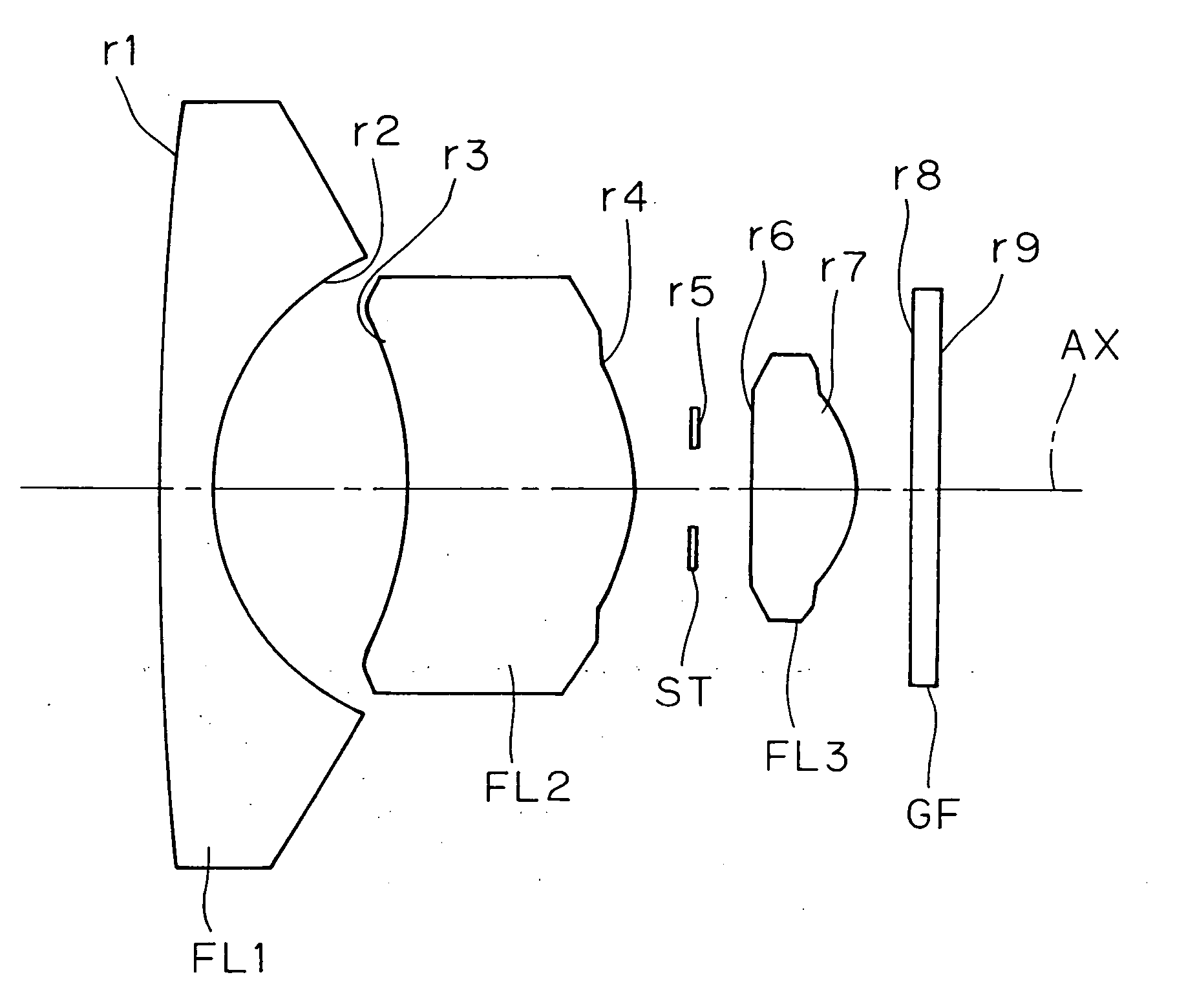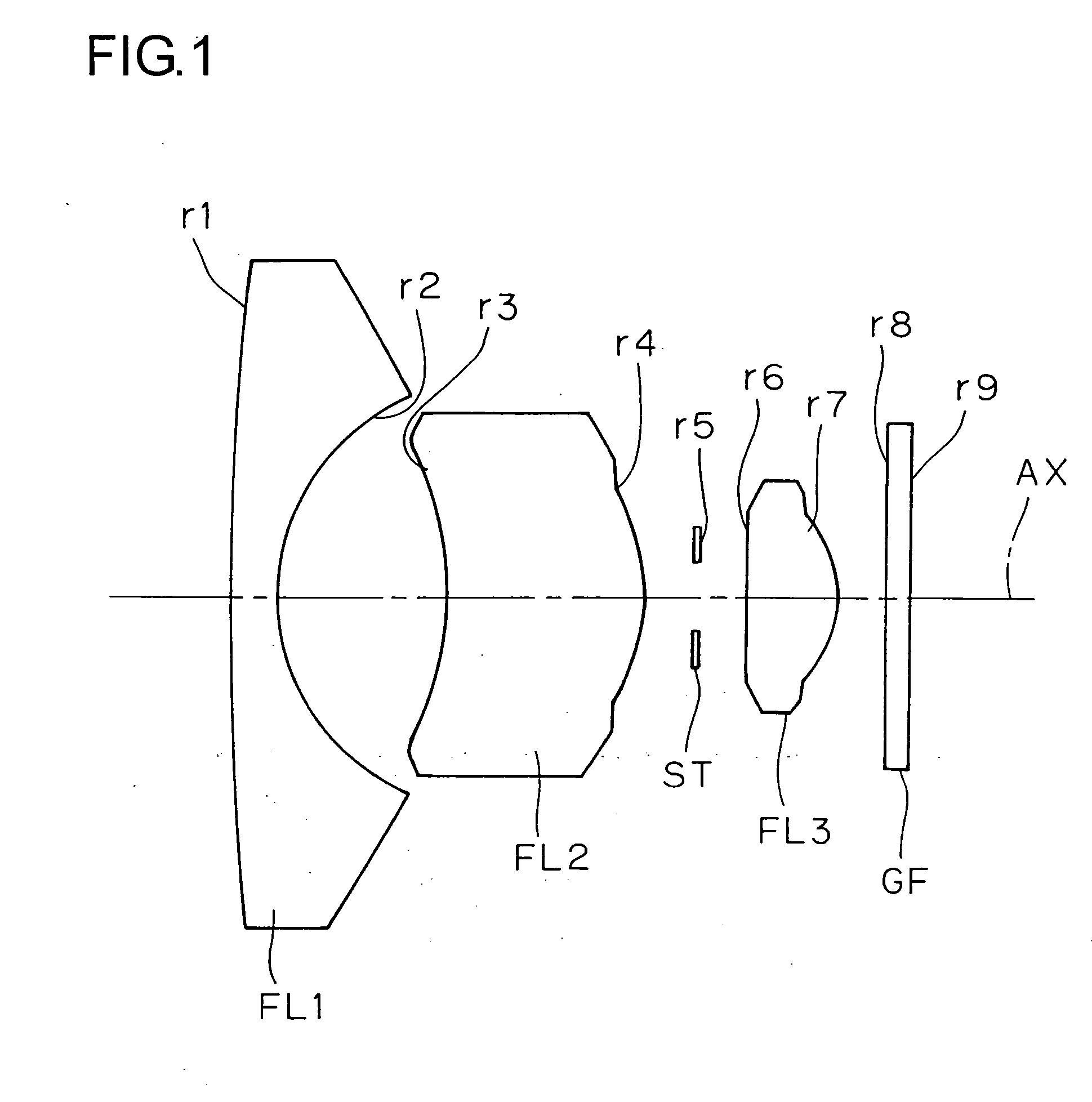Wide-angle lens system
a wide-angle lens and wide-angle technology, applied in the field of compact wide-angle lens systems, can solve the problems of long total lens length and super-wide-angle regions of photographs, and achieve the effect of excellent optical performan
- Summary
- Abstract
- Description
- Claims
- Application Information
AI Technical Summary
Benefits of technology
Problems solved by technology
Method used
Image
Examples
example 1
[0051] f=2.097
[0052] FNO=2.8
[Radius of[Axial[Refractive[Abbecurvature]distance]index]number]r1 = 66.638d1 = 1.053N1 = 1.58913ν1 = 61.25(FL1)r2 = 4.898d2 = 3.592N2 = 1.52510ν2 = 56.38(FL2)r3* = −6.435d3 = 4.212N3 = 1.52510ν3 = 56.38(FL3)r4* = −3.405d4 = 1.169N4 = 1.51680ν4 = 64.20(GF)r5 = ∞(ST)d5 = 1.091r6* = −21.168d6 = 1.976r7* = −2.124d7 = 1.000r8 = ∞d8 = 0.500r9 = ∞Σd = 14.593
[0053] [Aspherical surface data of the third surface (r3)][0054]ε=1.0 [0055] A4=0.15045×10−2 [0056] A6=0.16607×10−3 [0057] A8=−0.40815×10−4 [0058] A10=0.21958×10−5
[0059] [Aspherical surface data of the fourth surface (r4)][0060]ε=1.0 [0061] A4=0.13444×10−1 [0062] A6=−0.16674×10−2 [0063] A8=0.18304×10−3 [0064] A 10=−0.45788×10−6
[0065] [Aspherical surface data of the sixth surface (r6)][0066]ε=1.0 [0067] A4=−0.10863×10−1 [0068] A6=−0.16249×10−2 [0069] A8=0.88957×10−2 [0070] A10=−0.20908×10−2
[0071] [Aspherical surface data of the seventh surface (r7)][0072]ε=1.0 [0073] A4=0.12301×10−1 [0074] A6=0.24208×10...
example 2
[0077] f=1.875
[0078] FNO=2.8
[Radius of[Axial[Refractive[Abbecurvature]distance]index]number]r1 = 30.486d1 = 1.327N1 = 1.72916ν1 = 54.67(FL1)r2 = 4.779d2 = 3.677N2 = 1.52510ν2 = 56.38(FL2)r3* = −6.646d3 = 4.633N3 = 1.52510ν3 = 56.38(FL3)r4* = −3.158d4 = 0.810N4 = 1.51680ν4 = 64.20(GF)r5 = ∞ (ST)d5 = 1.195r6* = −11.029d6 = 1.978r7* = −1.971d7 = 1.000r8 = ∞d8 = 0.400r9 = ∞Σd = 15.019
[0079] [Aspherical surface data of the third surface (r3)][0080]ε=1.0 [0081] A4=0.54002×10−2 [0082] A6=−0.85537×10−3 [0083] A8=0.72417×10−4 [0084] A10=−0.27045×10−5
[0085] [Aspherical surface data of the fourth surface (r4)][0086]ε=1.0 [0087] A4=0.20553×10−[0088] A6=−0.57032×10−2 [0089] A8=0.13338×10−2 [0090] A10=−0.71240×10−4
[0091] [Aspherical surface data of the sixth surface (r6)][0092]ε=1.0 [0093] A4=−0.39253×10−2 [0094] A6=−0.57908×10−2 [0095] A8=0.13485×10−1 [0096] A10=−0.36536×10−2
[0097] [Aspherical surface data of the seventh surface (r7)][0098]ε=1.0 [0099] A4=0.15550×10−1 [0100] A6=0.64826×101...
PUM
 Login to View More
Login to View More Abstract
Description
Claims
Application Information
 Login to View More
Login to View More - R&D
- Intellectual Property
- Life Sciences
- Materials
- Tech Scout
- Unparalleled Data Quality
- Higher Quality Content
- 60% Fewer Hallucinations
Browse by: Latest US Patents, China's latest patents, Technical Efficacy Thesaurus, Application Domain, Technology Topic, Popular Technical Reports.
© 2025 PatSnap. All rights reserved.Legal|Privacy policy|Modern Slavery Act Transparency Statement|Sitemap|About US| Contact US: help@patsnap.com



